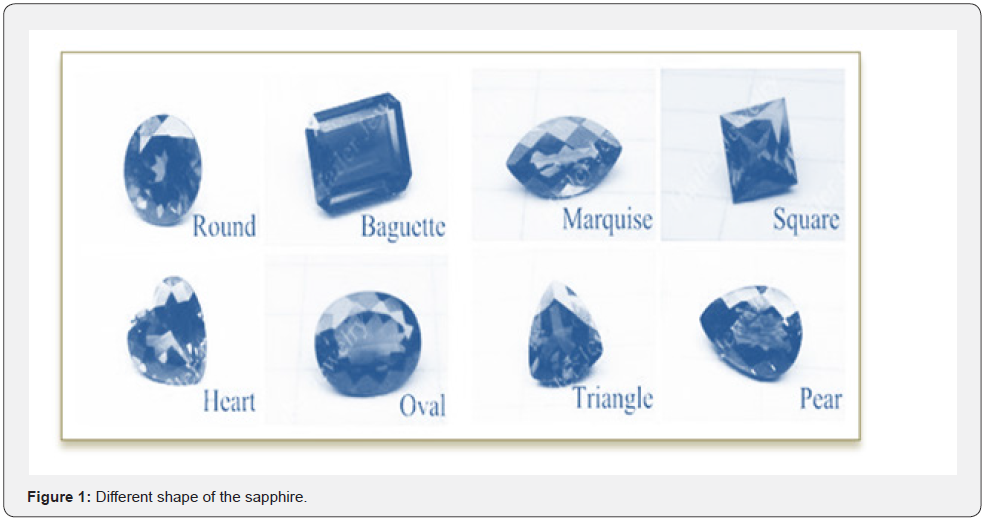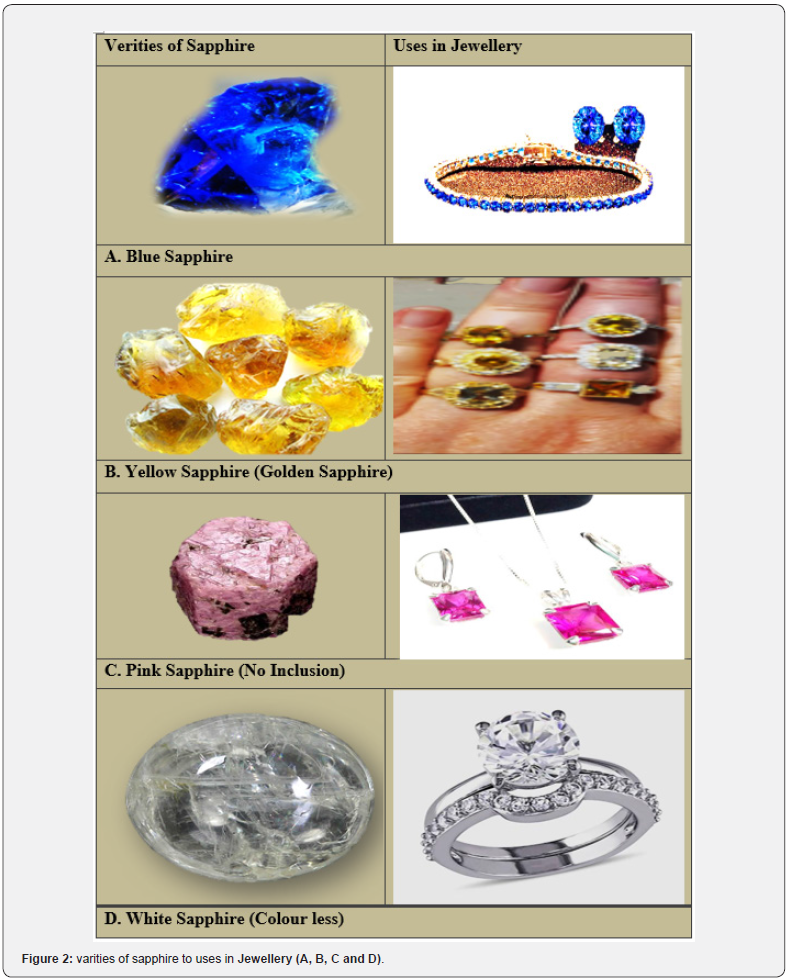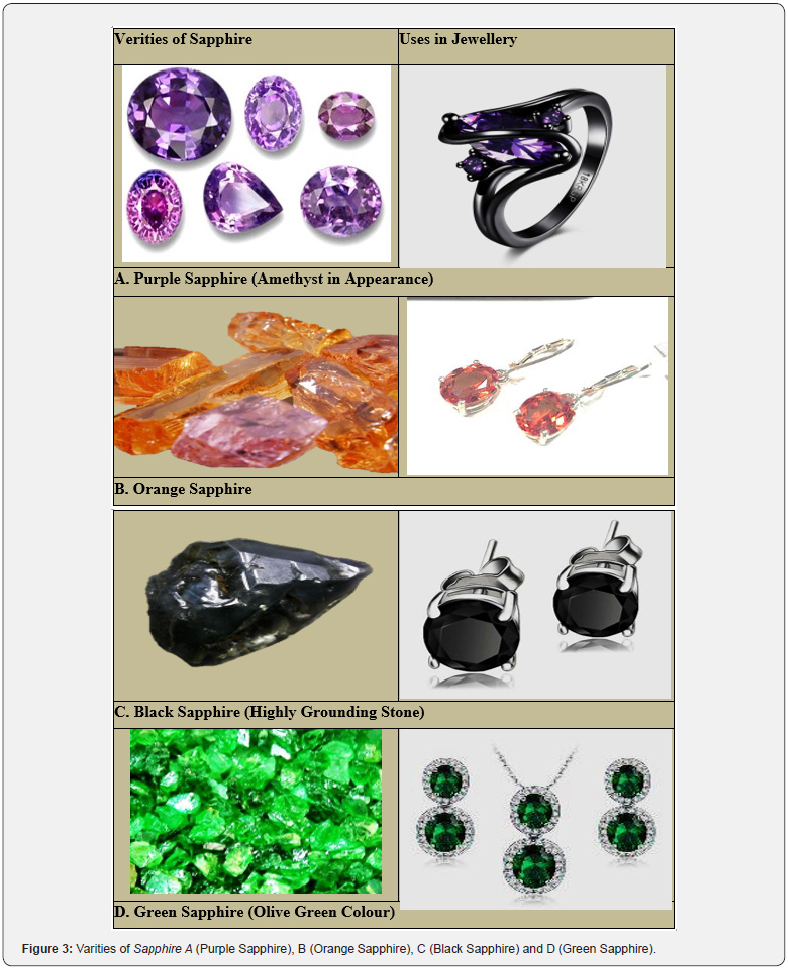A Historical Overview of Sapphire: An Approach from Birthstone to Gemstone
Asifa Shahab Ansari and Ajhar Hussain*
Community college, Women’s Polytechnic, Aligarh Muslim University, India
Submission: February 24, 2023; Published: March 10, 2023
*Corresponding author: Ajhar Hussain Department of Geology, Aligarh Muslim University Aligarh, India
How to cite this article: Asifa Shahab Ansari and Ajhar Hussain. An Historical Overview of Sapphire: An Approach from Birthstone to Gemstone. Curr Trends Fashion Technol Textile Eng. 2023; 8(2): 555733. DOI: 10.19080/CTFTTE.2023.08.555733
Abstract
Geology is concerned with earth science and the variously colored sapphires produced by natural processes. The sapphire has a history. Geographical location and the geological environment can be used to understand the origin. The major geological origins of sapphires, rubies, and emeralds are Kashmir, Burma, and Colombia, respectively. In some areas of the North-West Himalayas, sapphires can be found in large quantities. The form of the mineral corundum, an Aluminium oxide, sapphire is a valuable gemstone. It normally comes in blue, although it can also be found in yellow, purple, orange, and green. With weak cleavage, conchoidal fracture, and vitreous luster, sapphire is an oxide mineral with a trigonal crystal structure. For use in jewellery, natural sapphires are usually cut into gemstones and polished. They can be synthesized in laboratories to produce large crystal boules for use in industry or decoration. Sapphires have a remarkable Moh’s scale of hardness rating of 9, which is outstanding. Sapphires are used in many non-ornamental applications, such as infrared optical components, high-durability windows, wristwatch crystals and movement bearings, and very thin electronic devices, in addition to serving as an insulating material for highly specialized devices like LEDs.
Keywords: Geology; Gemstone; jewellery; India; Sapphire
Introduction
The birthstone for the month of September is the sapphire. The Latin word “sapphires” and the Greek word “sapphires,” both of which signify blue, are the origins of the term sapphire. Some people think that sapphire’s connection to Saturn is where the word sapphire came from. In several different languages, the term can be loosely translated as “dear to the planet Saturn”. A sapphire is a priceless jewel made of the mineral corundum. Despite coming in a variety of various colors, they are most well-known for their vivid blue hue. Sapphires have a fascinating past, including prominence with the royal family and involvement in fables from long ago. Consequently, sapphires are among the most in-demand gemstones for jewellery (alongside diamonds). On Earth, corundum is plentiful, whereas sapphire and ruby gemstones are very scarce. There are primary and secondary deposits of gem corundum. Corundum is found in primary deposits either as xenocrysts and xenoliths brought by magmas to the Earth’s surface or in the rocks where it crystallized. Corundum deposits are categorized using several mineralogical and geological characteristics. This is partially due to economic geologists discovering the value of such studies for understanding specific geological events and processes as well as for prospecting and mining of gemstone deposits [1-4]. The objective of the work is to delineate geological parameters of origin, geographical location of deposits, physical and gemological properties, varieties, cutting, shapes, and sizes, uses in different purposes of the sapphire.
Geological Deposits of Sapphire
In the global prospective, metamorphic blue sapphires typically form in settings where a deficiency in chromium is expected, such as from the interaction between Syenitic pegmatites and high-grade metamorphic rocks (Mogok, Myanmar) or from amphibolite or granulite facies gneisses (Sri Lanka and Madagascar) [5-9]. The gemstone-rich belts of Karur-Kangayam and Hole-Haripur, located in Tamil Nadu and Karnataka, respectively, in southern India, are well-known throughout the continent for producing sapphire, moonstone, iolite, aquamarine, garnet, sunstone, and corundum. In metamorphic terrain, corundum is a mineral that can be found in some marbles, gneiss, and mica schist. Additionally, it can be found in intrusive of nepheline syenite and low silica igneous syenite. Other occurrences include massive crystals in pegmatites, masses next to ultramafic intrusive, and those connected to lamprophyre dykes. As a result of its hardness and resistance to weathering, it frequently appears as a detrital mineral in streams and beach sand. In Assam, Meghalaya, and Maharashtra in India, it is discovered in combination with kyanite and sillimanite. In Andhra Pradesh, it can be found in syenites and ultrabasic rocks. A few outcrops of pegmatites that contain corundum can be found in the districts of Morena and Bastar in Madhya Pradesh and Chhattisgarh, respectively. At Mysuru and Subramanium in Karnataka, India, it is known that transparent to opaque ruby is abundant and occasionally accompanied by asteriscence. From the Kageyama belt in Tamil Nadu, which includes the Karur and Kulithalai tehsils in Tiruchirappalli district and the Vedachandur tehsil in Din-Digul district, precious and semi-precious corundum varieties have also been found. The Zanskar Range, which is in the Great Himalayan Mountain range and is divided from the Karakoram and Hindu Kush mountains by a feature known as the Indus suture through which the Indus River runs, is in the Himalayan belt. Even though little is known about the crystalline rocks of Zanskar, the local formations resemble those of the Hunza Valley in many ways [10]. One significant distinction is the age of the metamorphic, which are Cambro-Silurian in contrast to the younger Eocene rocks of the Karakoram Ranges [11,12].
Gemological Properties of Sapphire
The sapphire’s index qualities vary in color, trigonal crystal structure, hexagonal crystal structure (scalenohedral), massive crystal habit, and granular crystal habit. Conchoidal and splintery fracture, weak cleavage, Moh’s scale hardness of 9, vitreous luster, specific gravity between 3.95 and 4.03, transparency ranging from nearly opaque to transparent, strong pleochroism, insoluble by nature.
Sapphire Cut and Shape
Sapphire cut in different shape and size, like round, baguette, marquise, squire, heart, oval, triangle and pear shapes.
Verities of Sapphire
Sapphires with colors other than blue are prefixed with their respective color designations in addition to the kinds of sapphire listed below. In addition to blue sapphire, the primary gemstone colors are:

Natural sapphire
Corundum is the formal word for sapphire crystal. A sapphire (corundum) is a mineral made of Aluminium oxide (Al2O3). Hexagonal crystals make up its structure. Sapphires are available in a wide variety of hues, including blue, black, colorless, and all shades in between. In a sapphire, there are no restrictions on color saturation or tone. Because of the trace mineral concentration within a sapphire crystal, sapphires come in a variety of colors. Due to the titanium element present in the crystal, a blue sapphire will reflect blue light. A sapphire will be pink in color if it contains other trace minerals, such as chromium [13].
Blue sapphire
The incredibly precious blue gemstone known as Blue Sapphire (Neelam Stone) is a member of the Corundum mineral family. It ranges in color from a very light royal blue to a very dark cornflower blue. Blue sapphires get their blue color from the titanium mineral that is present inside the crystal. More titanium is present in sapphire, which results in more color saturation. There are several different properties available, some of which are magnificent, unspoiled, and cheaply priced. Occurs in places like Sri Lanka (Ceylon), Burma, and Kashmir.
Yellow sapphire
It has a very pale canary to extremely golden color tone (sometimes also called “Golden Sapphire” if intensely colored). The only significant supplier of high-quality yellow sapphires is Sri Lanka (Ceylon). Most yellow sapphires are clear and dazzling. The crystal is exceptionally stunning in most lighting conditions, from soft dusk light to strong direct sunlight.
Pink sapphire
It is very pale baby pink to a vivid almost magenta intense pink. It forms because of heating blue and yellow sapphires at extremely high temperatures for an extended length of time (3–10 days at up to 1800C) while using fluxes and other color additives. No inclusion is present because internal inclusions in sapphires change significantly when they are treated to high temperatures. The “ID” of a heated sapphire can be seen by looking at these significantly altered interior inclusions. Fine pink sapphires are extremely uncommon and have only been discovered in a few places in Vietnam, Sri Lanka, and Burma.
White sapphire
Describes Sapphire that is colorless white sapphires are pure sapphires and white sapphires has no internal minerals. It is extremely rare to get a sapphire crystal that is chemically pure. These gems are made only of corundum (sapphire). White sapphires that are entirely natural and untreated resemble diamonds in appearance because they exhibit outstanding light reflection in direct sunshine. We typically have fewer than a dozen stones available at any given time because the number of natural, untreated white sapphires being discovered at this time is so small [14-16].
Green sapphire
The green color is light lime green to an olive-green color. Significant levels of secondary colors like blue and yellow can be found in these stones. Green sapphires are typically not very expensive. Color saturation has just a minor impact on these stones’ prices. The lighter, brighter green sapphires are often more valuable because they reflect light and color more effectively than the darker, more intense green sapphires. With some recent deposits being mined in Madagascar as well, the primary sources of green sapphires are Sri Lanka and Tanzania.
Purple sapphire
Due to the difficulty in obtaining fine stones in consistent quantities, purple sapphires are quite rare. The most popular of the purple gemstones, amethyst, shares a color with exquisite purple sapphires most of the time. By no means should purple sapphires be mistaken for amethyst in appearance. Sapphires reflect and refract light significantly stronger than amethyst and are immensely tougher and more durable. Amethyst can dull, scrape, and perhaps shatter with everyday wear, while purple sapphires will endure a lifetime. The color of purple sapphires can range from a pastel shade to an extremely deep, vivid shade. The stronger intensity, the higher the price. Most purple sapphires are natural and come from Madagascar and Sri Lanka. Large sizes larger than 6 carats are very pricey and unusual.
Orange sapphire
It falls within the Padparadscha and Ruby categories. Most of the time, the rare sapphires with reddish colouring are grossly undervalued. These Padparadscha replicas are mostly found in Tanzania and Madagascar.
Black sapphire
Corundum, an Aluminium oxide mineral that occurs in prismatic tabular, rhombohedral, or bipyramidal crystals and ranges in transparency from opaque, is the variant of black sapphire. It is a very powerful stone for grounding, and it will also focus and shield your body and the energy around you. Australia is where most black sapphires are found
Application of sapphire
One of the most popular gemstones, sapphire, is widely used in jewellery. Deep, blue-colored fine colored sapphire with outstanding transparency can cost several thousand dollars per carat. The blue variant is most frequently used in jewellery, but “fancies” in yellow, pink, and orange have recently gained a lot of popularity. Although less popular, green, and light blue sapphires are also known and used in jeweler. A small gemstone is opaque black sapphire. All types of jewellery, including bracelets, necklaces, rings, and earrings, contain sapphire. Both as the main gemstone in pendants and rings and as a subsidiary stone to accentuate other gemstones like diamonds, it is utilized in jewellery. If clear, star sapphires are polished as cabochons and are very expensive. Even more precious than the excellent blue Sapphire is the uncommon orange-pink variation known as Padparadschah. Sometimes blue sapphire, especially the less translucent variety, is carved into cameos or miniature sculptures. Natural material is frequently replaced by synthetic sapphire since it is less expensive [17-20].
Conclusion
General information related to sapphire is very important in gems and jewellery design industry. Particularly traditional metamorphic sapphires from Kashmir, Burma, or Sri Lanka that have not undergone heat-treatment may have a higher economic appeal than those from other regions or categories. Different varieties of sapphire and its gemological properties and its uses in different jewellery design and electric instruments are very useful. Finally, the present overview of the paper revealed that the different varieties of Sapphire are very important resources as per nation building with economic evaluation.


References
- Mendis DPJ, Rupasinghe MS, Dissanayake CB (1993) Application of structural geology in the exploration for residual gem deposits of Sri Lanka. Bulletin of the Geological Society of Finland 65(1-2): 31-40.
- Chow VW, Mendis DA, Rosenberg M (1993) Role of grain size and particle velocity distribution in secondary electron emission in space plasmas. Journal of Geophysical Research: Space Physics 98(A11): 19065-19076.
- Cook FA (1997) Applications of geophysics in gemstone exploration. Gems & Gemology 33(1): 4-23.
- Simonet C, Okundi S, Masai P (2000) General setting of colored gemstone deposits in the Mozambique Belt of Kenya—preliminary considerations. In: Proc. 9th Conf Geol Soc, Nairobi, Kenya, pp. 123-138.
- Giuliani G, Ohnenstetter D, Fallick AE, Groat LA, Fagan AJ, et al. (2014) The geology and genesis of gem corundum deposits. In: Geology of Gem Deposits. (2nd ), Groat LA, (Edt.), Short Course Series Mineralogical Association of Canada. Quebec City, Canada, 44: 29-11244.
- Giuliani G, Dubessy J, Ohnenstetter D, Banks D, Branquet Y, et al. (2018) The role of evaporites in the formation of gems during metamorphism of carbonate platforms A review Miner Depos 53(2): 1-20.
- Giuliani G, Groat LA (2019) Geology of corundum and emerald gem deposits: A review. Gems Gemmal 55: 464–489.
- Garnier V, Giuliani G, Ohnenstetter D, Fallick AE, Dubessy J, et al. (2008) Marble-hosted ruby deposits from Central and Southeast Asia Towards a new genetic model Ore Geol Rev 34(1-2): 169-191.
- Simonet C, Fritsch E, Lasnier BA (2008) classification of gem corundum deposits aimed towards gem exploration. Ore Geol Rev 34(1-2): 127–133.
- Gubelin E. J. (1982) Gemstone of Pakistan: emerald, ruby, and spinel. Gems & Gemology 18(3): 123-139.
- Lydekker L (1883) Geology of Kashmir and Chamba, Memoirs of the Geological Survey of India 22: 335-336.
- Ganseer A (1964) Geology of the Himalayas. John Wiley & Sons New York, USA.
- thenaturalsapphirecompany.com.
- minerals.net.
- net.
- wikipedia.org.
- annaslegacy.com.
- ranaweeragems.lk.
- gemsinsrilanka.com.
- ismenvis.nic.in.






























